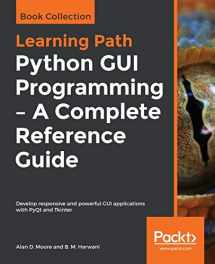
Python GUI Programming - A Complete Reference Guide
Book details
Summary
Description
Explore Python's GUI frameworks and create visually stunning and feature-rich applications
Key Features- Integrate stunning data visualizations using Tkinter Canvas and Matplotlib
- Understand the basics of 2D and 3D animation in GUI applications
- Explore PyQt's powerful features to easily design and customize your GUI applications
A responsive graphical user interface (GUI) helps you interact with your application, improves user experience, and enhances the efficiency of your applications. With Python, you'll have access to elaborate GUI frameworks that you can use to build interactive GUIs that stand apart from the rest.
This Learning Path begins by introducing you to Tkinter and PyQt, before guiding you through the application development process. As you expand your GUI by adding more widgets, you'll work with networks, databases, and graphical libraries that enhance its functionality. You'll also learn how to connect to external databases and network resources, test your code, and maximize performance using asynchronous programming. In later chapters, you'll understand how to use the cross-platform features of Tkinter and Qt5 to maintain compatibility across platforms. You'll be able to mimic the platform-native look and feel, and build executables for deployment across popular computing platforms.
By the end of this Learning Path, you'll have the skills and confidence to design and build high-end GUI applications that can solve real-world problems.
This Learning Path includes content from the following Packt products:
- Python GUI Programming with Tkinter by Alan D. Moore
- Qt5 Python GUI Programming Cookbook by B. M. Harwani
- Visualize graphs in real time with Tkinter's animation capabilities
- Use PostgreSQL authentication to ensure data security for your application
- Write unit tests to avoid regression when updating code
- Handle different signals generated on mouse clicks using QSpinBox and sliders
- Employ network concepts, internet browsing, and Google Maps in UI
- Use graphics rendering to implement animations in your GUI
If you're an intermediate Python programmer looking to enhance your coding skills by writing powerful GUIs in Python using PyQT and Tkinter, this is an ideal Learning Path for you. A strong understanding of the Python language is a must to grasp the concepts explained in this book.
Table of Contents- Introduction to Tkinter
- Designing GUI Applications with Tkinter
- Creating Basic Forms with Tkinter and ttk Widgets
- Reducing User Error with Validation and Automation
- Planning for the Expansion of Our Application
- Creating Menus with Menu and Tkinter Dialogs
- Navigating Records with Treeview
- Improving the Look with Styles and Themes
- Creating Automated Tests with unittest
- Improving Data Storage with SQL
- Connecting to the Cloud
- Visualizing Data Using the Canvas Widget
- Creating a User Interface with Qt Components
- Event Handling - Signals and Slots
- Understanding OOP Concepts
- Understanding Dialogs
- Understanding Layouts
- Networking and Managing Large Documents
- Database Handling
- Using Graphics
- Implementing Animation
- Using Google Maps


We would LOVE it if you could help us and other readers by reviewing the book
Book review



